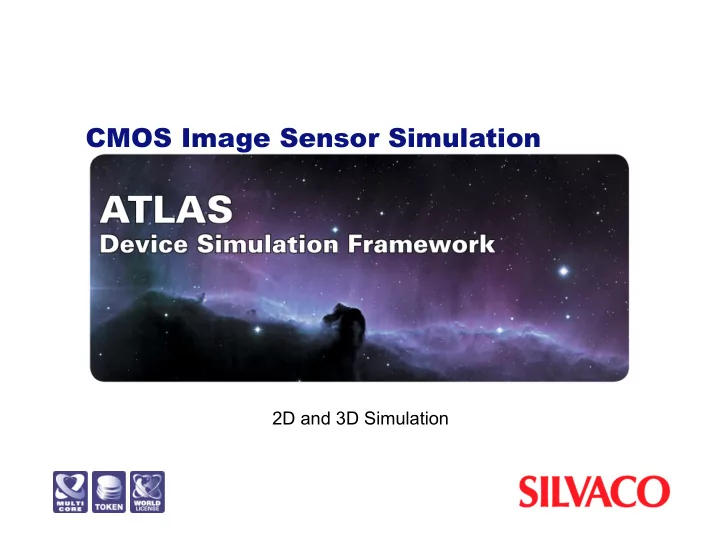

CMOS Image Sensor Simulation 2D and 3D Simulation
Basic Structure and operation of CMOS Image Sensor CMOS Image Sensor CMOS Image Sensor cross section of (PD/TG_2/FD): equivalent circuit TG_1 TG FD PD TG_2 FD PD TG_3 TG_3 - 2 - CMOS Image Sensor Simulation – 2D and 3D Simulation n
Basic Structure and operation of CMOS Image Sensor Same as Photodetector/Solar Cell Light Light Charge (electron/hole) conversion n p ATLAS: Device Simulator with Luminous module ammeter Accumulation of Current generated charges (electrons) A potential well is formed, into which electrons are accumulated. Holes will flow (Holes may also be used) to P-type layer. Transfer from PD to FD Electrons will be converted to voltage (See the next page) (q=CV) and they will be output through the source follower (AMPn) Charge Voltage conversion - 3 - CMOS Image Sensor Simulation – 2D and 3D Simulation n
Basic Structure and operation of CMOS Image Sensor Potential during accumulation Potential during transfer Potential during output (@off) (@on) (@off) PD TG PD TG PD TG FD FD FD Design of the potential resulting in charge transfer is critical. If the accumulation capacity in PD and FD is out of balance, untransferred charges will occur. - 4 - CMOS Image Sensor Simulation – 2D and 3D Simulation n
Basic Structure and operation of CMOS Image Sensor Potential profile simulated using ATHENA + ATLAS Potential during accumulation (@off) Potential during transfer (@on) Light :532nm TG PD PD TG FD FD - 5 - CMOS Image Sensor Simulation – 2D and 3D Simulation n
Basic Structure and operation of CMOS Image Sensor CMOS Sensor Performance ATLAS ○ Light (Input) Luminous Determined by the structure (material and geometry) ○ P hotoelectric conversion ATLAS Determined by the structure (doping) ATHENA ○ Charge/Voltage conversion (output) Determined by total capacity of FD (junction + wiring) ATLAS CLEVER - 6 - CMOS Image Sensor Simulation – 2D and 3D Simulation n
2D Process and Device Simulation Example CIS Process simulation including Back End and lens to focus light Un-saturated and saturated DC IV characteristics show low leakage current all the way up to Vg=1V - 7 - CMOS Image Sensor Simulation – 2D and 3D Simulation n
2D Process and Device Simulation Example The light is shone on the structure during 50us. Potential of the N- region gradually decreases as the light generated carriers are integrated At around 3us the image sensor is saturated At 50us the gate is ramped in transient to 3.3V to transfer the charge previously generated in the N- region to the floating drain - 8 - CMOS Image Sensor Simulation – 2D and 3D Simulation n
Comparison of Several Lenses Design All lenses are spherical but have different radiuses Built-in analytical lenses are used during FDTD simulation The advantage is to prevent the introduction of lot of mesh points during the device simulation and to reduce simulation time. - 9 - CMOS Image Sensor Simulation – 2D and 3D Simulation n
Charge Integration Analysis We examine the time integration of charge in the N Well of the imaging device and look at crosstalk caused by charge blooming into an adjacent cell Green Pixel Red Pixel - 10 - CMOS Image Sensor Simulation – 2D and 3D Simulation n
Crosstalk at Angular Incidence Crosstalk between adjacent colors due to angularly incident light After about 20 degrees the collected Green rate decreases - 11 - CMOS Image Sensor Simulation – 2D and 3D Simulation n
3D CMOS Image Sensor Simulation Example Layout – GDSII or Silvaco Layout Format (MaskViews) - 12 - CMOS Image Sensor Simulation – 2D and 3D Simulation n
3D CMOS Image Sensor Simulation Example All 8 Masks using Lithography Simulation using VICTORY CELL - 13 - CMOS Image Sensor Simulation – 2D and 3D Simulation n
3D CMOS Image Sensor Simulation Example All 4 Implants using 4 Million Trajectories for Each Implant using VICTORY CELL Showing shadowing of the photoresist for the high angle implants and scattering effects. - 14 - CMOS Image Sensor Simulation – 2D and 3D Simulation n
3D CMOS Image Sensor Simulation Example Targeted light exposure only in Image Sensor active region. - 15 - CMOS Image Sensor Simulation – 2D and 3D Simulation n
3D CMOS Image Sensor Simulation Example 3D transient device simulation showing optical and voltage pulse - 16 - CMOS Image Sensor Simulation – 2D and 3D Simulation n
Summary SILVACO TCAD tools provide a complete solution for researchers interested in CMOS Image Sensor (CIS) technology. It enables researchers to study the electrical properties of CIS under illumination in both two and three dimensional domains. 3D process simulation, not just 3D structure editing Can be used for fast prototyping of large structures or detailed analysis of intricate details The software is capable of simulating any type of CIS and the calibration task is now very convenient and easy thanks to VWF Silvaco is the one-stop vendor for all companies interested in CIS technology simulation solutions - 17 - CMOS Image Sensor Simulation – 2D and 3D Simulation n
Recommend
More recommend